
Zagreb is the capital and largest city of Croatia. It is in the northwest of the country, along the Sava river, at the southern slopes of the Medvednica mountain. Zagreb lies at an elevation of approximately 122 m (400 ft) above sea level. The population of the city in 2021 was 769,944. The population of the Zagreb urban agglomeration is 1,071,150, approximately a quarter of the total population of Croatia.

Franjo Tuđman, also written as Franjo Tudjman, was a Croatian politician and historian. Following the country's independence from Yugoslavia, he became the first President of Croatia and served as president from 1990 until his death in 1999. He was the 9th and last President of the Presidency of SR Croatia from May to July 1990.

The president of Croatia, officially the President of the Republic of Croatia, is the head of state, commander-in-chief of the military and chief representative of the Republic of Croatia both within the country and abroad. The president is the holder of the highest office in Croatia. However, the president is not the head of the executive branch as Croatia has a parliamentary system in which the holder of the post of prime minister is the most powerful person within the country's constitutional framework and everyday politics.
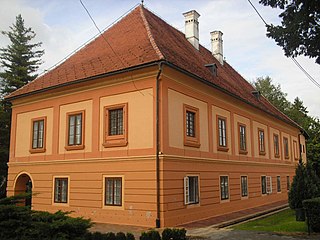
Zagreb County is a county in central Croatia. It surrounds, but does not contain, the nation's capital Zagreb, which is a separate territorial unit. For that reason, the county is often nicknamed "Zagreb ring". According to the 2011 census, the county has 317,606 inhabitants, most of whom live in smaller urban satellite towns.

Velika Gorica is the largest and most populous city in Zagreb County, Croatia. According to the 2011 census the city itself has a population of 31,341, while the municipality has a population of 63,517 inhabitants.

Tourism in Croatia is a major industry of country's economy, accounting for almost 20% of gross domestic product (GDP).
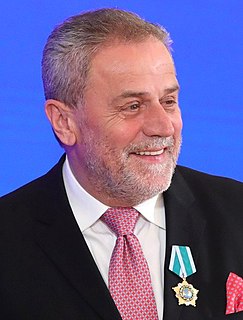
Milan Bandić was a Croatian politician and the longest-serving mayor of Zagreb, the capital of Croatia. Bandić was mayor almost continuously from 2000 to 2021, except during the time between his resignation in 2002 and the 2005 election. He was also suspended from exercising his powers and duties for several months after his 2014 arrest over a corruption scandal. Out of Bandić's multifaceted engagement in politics, the most noted part was his mayoralty of Zagreb, which followed the Croatian Democratic Union's (HDZ) first post-socialist period of government (1990–2000), and exacerbated many existing transitional problems in the city.
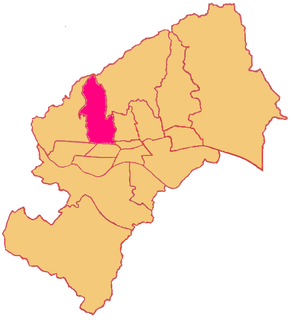
Črnomerec is one of the city districts of Zagreb, Croatia. It is located in the western part of the city and has nearly forty thousand inhabitants.
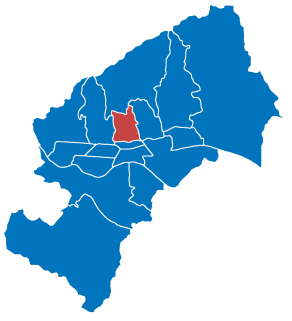
Gornji Grad–Medveščak is one of the districts of Zagreb, Croatia; Gornji Grad translates as "Upper Town", referring to its historical location on city's hillside, being above Donji Grad. The district is located in the central part of the city and, according to the 2011 census, it has 30,962 inhabitants spread over 10.19 km2 (3.93 sq mi).

Kralj Petar Krešimir IV is a Kralj-class missile boat in service with the Croatian Navy. It was laid down in 1990 at the Kraljevica Shipyard as the first ship in a new class being built for the Yugoslav Navy. As the Croatian War of Independence started gaining momentum, shipyard workers stalled the completion of the ship until the remaining Yugoslav forces retreated, preserving the ship for the Croatian Navy that was being formed.

Zagreb Franjo Tuđman Airport or Zagreb Airport is an international airport serving Zagreb, Croatia. It was the largest and busiest airport in Croatia until 2021, when it handled 1.4 million passengers and was surpassed for the first time by Split Airport, which handled 1.57 million passengers. In 2019, however, Zagreb handled 3.45 million passengers and some 13,000 tons of cargo while Split handled 3.1 million.
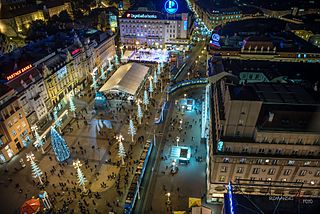
Ban Jelačić Square is the central square of the city of Zagreb, Croatia, named after Ban Josip Jelačić. The official name is Trg bana Jelačića. The square is colloquially called Jelačić plac.

The Battle of the Barracks was a series of engagements that occurred in mid-to-late 1991 between the Croatian National Guard and the Croatian police on one side and the Yugoslav People's Army (JNA) on the other. The battle took place around numerous JNA posts in Croatia, starting when Croatian forces blockaded the JNA barracks, weapons storage depots and other facilities. It formally began on 14 September; its objective was to neutralise the JNA positions in ZNG-held territory and to secure arms and ammunition supplies for the poorly equipped ZNG.

Martin Špegelj was a Croatian army general and politician who served as the second defense minister of Croatia and, later, the chief of staff of the newborn Croatian army and inspector-general of the army. His efforts to organize and equip the army from scratch were seen as instrumental in helping Croatia survive the first year of the Croatian War of Independence. Partly owing to disagreements with president Franjo Tuđman, he retired in 1992, after the war froze with the permanent ceasefire at the end of 1991.
St. Mark's Square is a square located in the old part of Zagreb, Croatia, called Gradec or Gornji grad.

Republic of Croatia Square is one of the biggest squares in Zagreb, Croatia. The square is located in Lower Town, with the Croatian National Theatre building at its centre. It is sometimes billed as the "most beautiful square in Zagreb".

The bombing of the Banski Dvori was a Yugoslav Air Force strike on the Banski Dvori in Zagreb—the official residence of the President of Croatia at the time of the Croatian War of Independence. The airstrike occurred on 7 October 1991, as a part of a Yugoslav Air Force attack on a number of targets in the Croatian capital city. One civilian was reported killed by strafing of the Tuškanac city district and four were injured.
The following is a timeline of the history of the city of Zagreb, Croatia.
The siege of Bjelovar Barracks, also known by the codename Operation Bilogora, was the blockade and capture of the Yugoslav People's Army (JNA) barracks and other facilities in and around the city of Bjelovar, a part of the JNA 32nd (Varaždin) Corps, during the Croatian War of Independence. A general blockade of the JNA facilities in Croatia was ordered on 14 September 1991, and it continued until 29 September when the JNA garrison was captured by Croatian forces. Its capture occurred one week after the bulk of the 32nd Corps surrendered. It was part of the Battle of the Barracks—an effort by Croatian armed forces to isolate JNA units based at barracks in Croatia, or capture the barracks to provide arms for Croatia's nascent army.

Croatian Nobles Square is one of the central squares in Zagreb. It was designed in 1923 urban plan as entry to the then new eastern part of the town. Draškovićeva street is on the western side of the square, Martićeva street begins on the north side, while a road and tram line go through the middle of the square to the Rački street and Square of the Victims of Fascism.


















